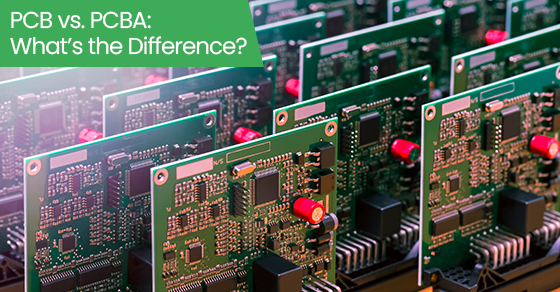PCB vs. PCBA: What’s the Difference?
A printed circuit board (PCB) is likely present in every electronic device you have in your home and most of those you encounter elsewhere daily.
PCB generally describes the central component that physically and mechanically supports electronic devices by connecting all electronic components within them. PCBs are used in various devices and across an even wider range of industries.
PCBs are made from non-insulating and highly heat-resistant materials, such as fibreglass, and they use conductive metals, like copper, to forge conductive circuits or traces for electricity to flow in a controlled way.
These circuit boards can vary in design depending on the devices they are designed for use and can be made to have single, two, or multiple layers. PCBs can also be rigid, flexible, or can contain both rigid and flexible parts.
What is a PCBA, and how does it differ from a PCB?
Another term often tossed around in the electronics industry is “PCBA,” which is often misunderstood to mean the same thing as “PCB,” but these terms are technically not interchangeable.
Although these terms are connected, there are some distinct differences between their uses, and it is essential to understand what a PCBA is and how it differs from a PCB.
After being designed, a PCB assembly process ensues, during which active and passive electronic components, such as a resistor, SMD capacitor, transistor, transformer, and diode, are added. These varied components are generally added to a PCB using different soldering methods, including wave soldering, reflow soldering, or hand soldering.
Only after these components have been assembled or soldered onto the PCB can it be considered a printed circuit board assembly (PCBA) and ready for use in an electronic device.
A PCB and PCBA are the results of two different steps from the same process. While a PCB is a blank circuit board with no electronic components attached to it, a PCBA is a completed assembly with all the components required to function.
Of course, completing a PCBA is a more complicated process than merely producing a blank PCB, and, as such, it is also more costly. Yet, you must create a PCBA with a PCB first.
Although, technically, PCBAs are the central components contained in most electronic devices around the world, not PCBs, PCB is the term more widely applied to this kind of technology.
What are the main methods used in PCBA?
At times, the term PCBA may also be used to describe assembling the circuit board with the components it needs. Two predominant methods are used for this assembly process, which differ from each other in significant ways. These two methods are surface mount technology (SMT) and thru-hole technology.
Surface-Mount Technology (SMT)
As its name suggests, the surface-mount technology assembly process involves mounting electronic components to the surface of a PCB. This highly automated process makes higher connection densities possible, enabling PCB manufacturers to place complex circuitries into tiny components. Four basic steps are part of the SMT process.
First, solder paste must be placed where it is needed on the board. Afterward, the assembler can place the components in their designated spots on the board with a pick-and-place machine.
After that, the board is heated in a reflow oven until the solder paste reaches a specific temperature and solder joints form. Inspections are conducted by the assembler throughout this process.
Thru-Hole Technology
The thru-hole technology assembly is an older technology than SMT. However, it is still used, as it creates more robust connections between the board and the components, making for more durable and reliable assemblies. This process involves drilling holes into a PCB and attaching electronic components called leads through these holes.
The thru-hole technology process can be either semi-automated or fully automated and, like the SMT process, includes four basic steps.
First, holes must be drilled into the board that is the right size for the component leads, then the leads are placed in these holes. After that, soldering must be done to keep the leads in place.
Inspections must be conducted by the assembler throughout the process to ensure that the PCBA is functioning correctly.
How Circuits Central Can Help You Design and Manufacture Top-Quality PCBs and PCBAs
Our seasoned experts at Circuits Central would be happy to help if you require PCB manufacturing in Toronto. With access to our state-of-the-art PCB manufacturing and assembly facility and our flexible-by-design services, you can be sure that your PCBs or PCBAs will come out well.
We can handle a range of complexities regarding PCBs and PCBAs and manage both small and large production volumes, as we can scale and modify our approach based on your specific needs.
Our advanced industry knowledge, skills, and equipment allow us to handle everything from material management to PCB assembly to cable assembly to product testing and integration.
We are experts in surface-mount and thru-hole technology assembly. We can offer automated versions of either of these processes. Most importantly, we always prioritize speed and efficiency just as much as we do quality to minimize delays in your PCBA process.
For more information about how we can help you produce quality PCBs or PCBAs or to learn more about our other services, call Circuits Central at 1 (888) 602-7264 or email us at info@circuits-central.com.

